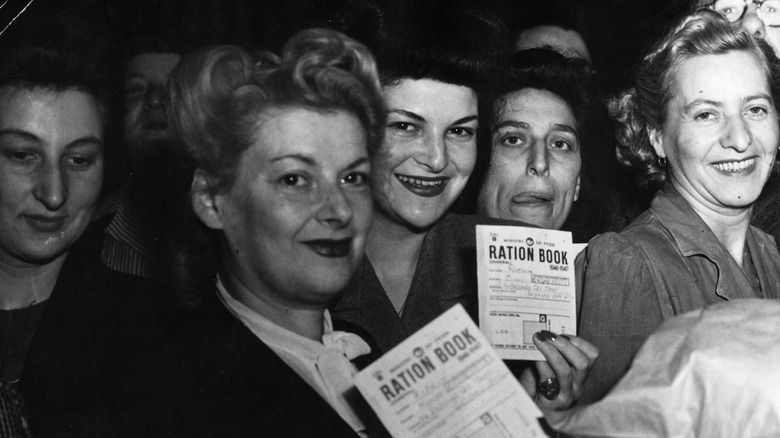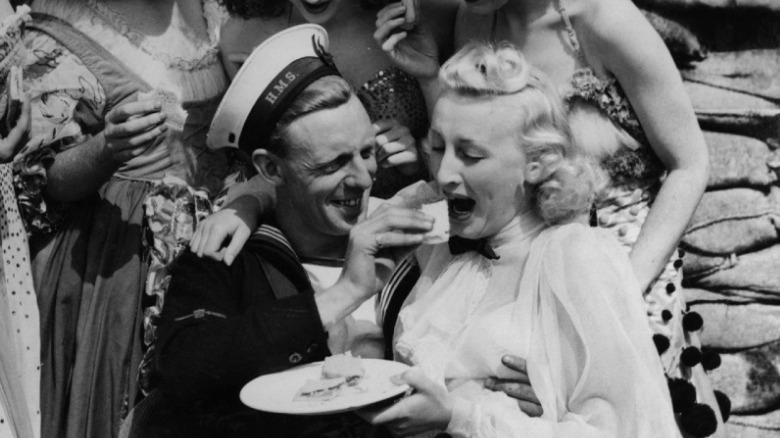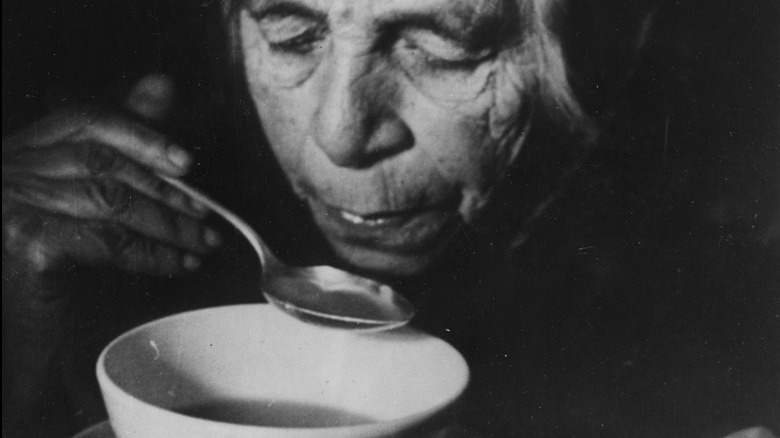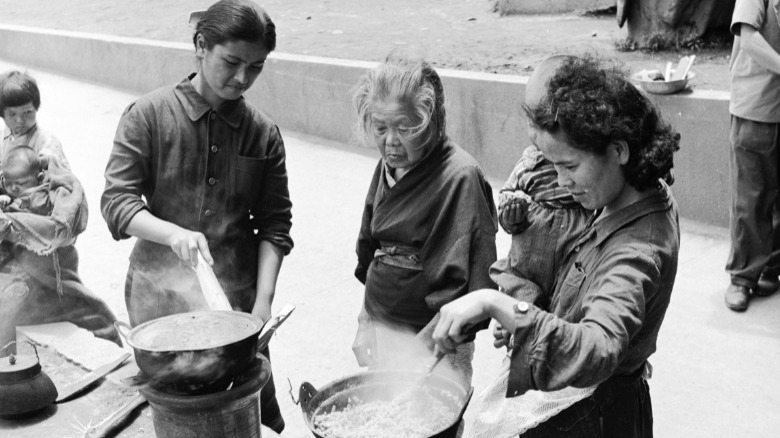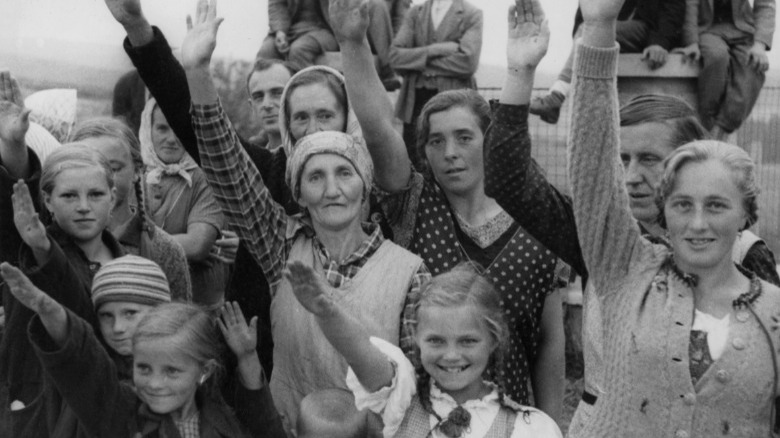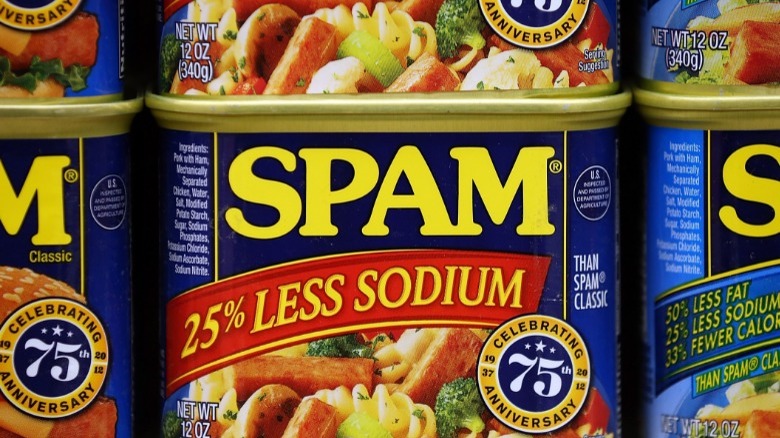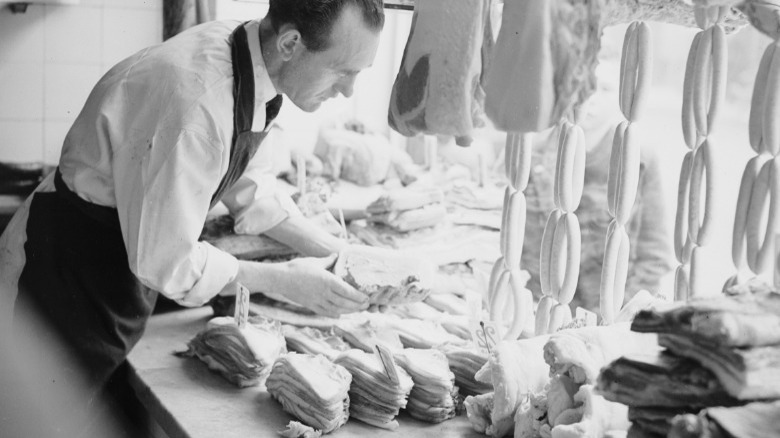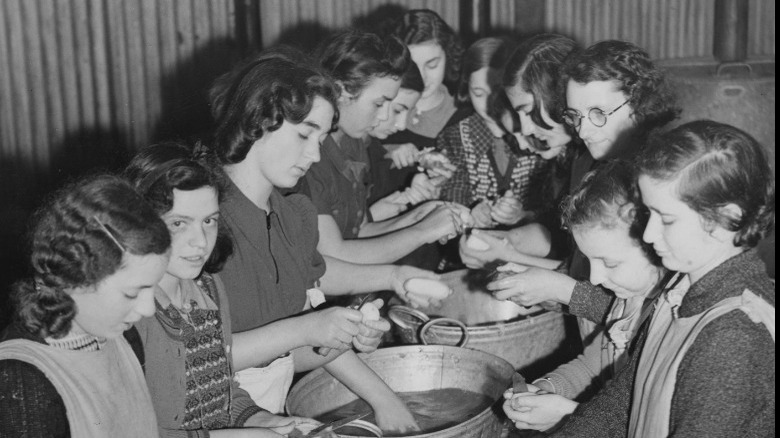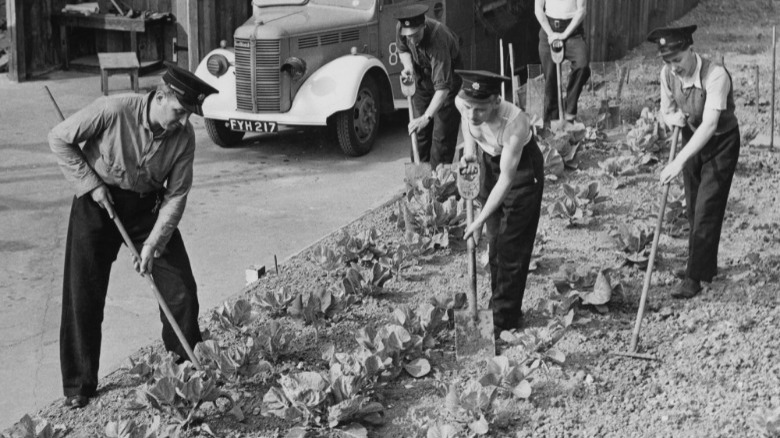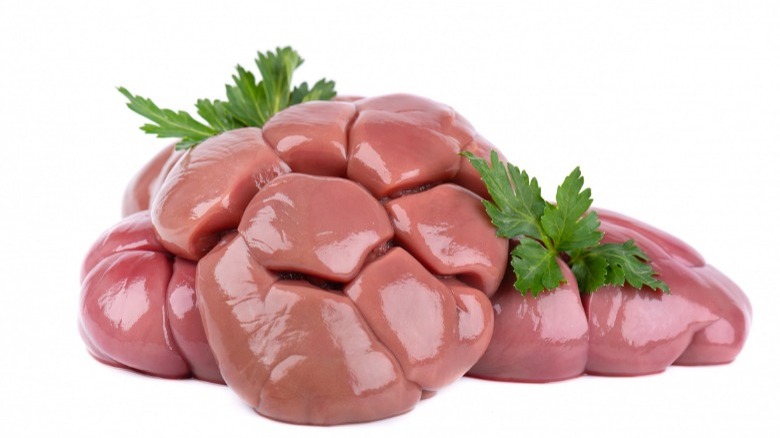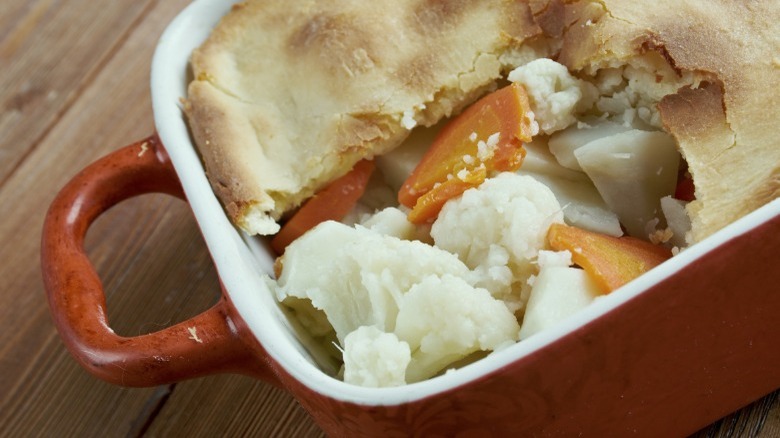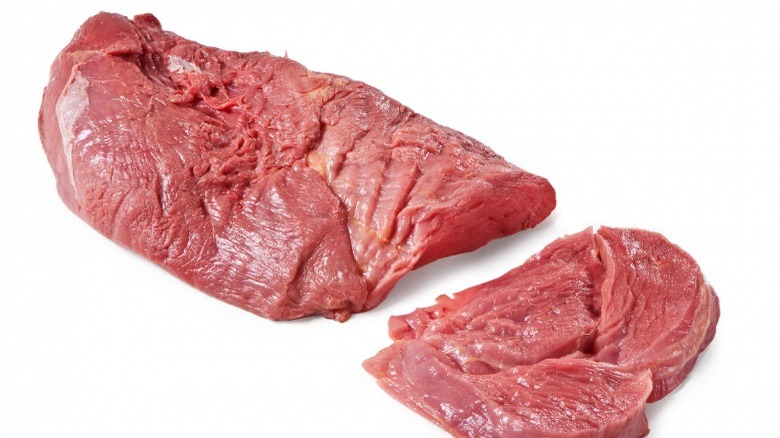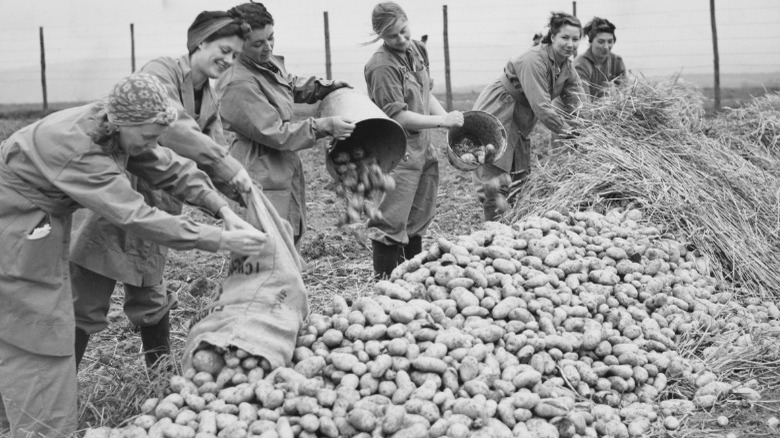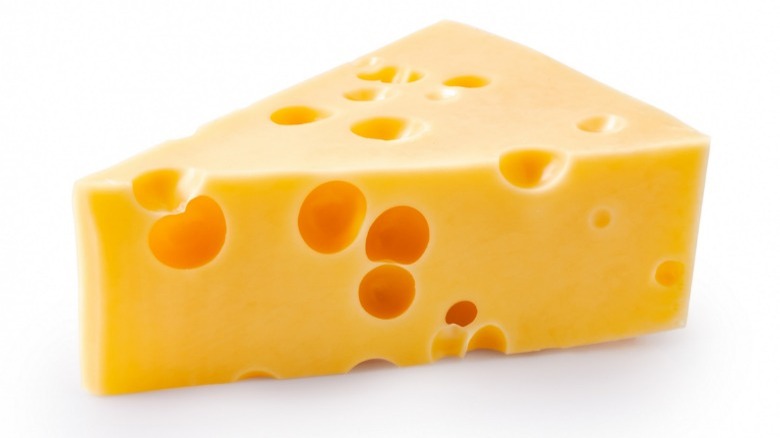What People Ate While Rationing During WW2
During World War II, food rationing was implemented by the warring nations, including Great Britain, the United States, the Soviet Union, Nazi Germany, and imperial Japan. Millions of men, women, and children were given coupons and ration books to manage their supply of foodstuffs, such as sugar, meat, fats, bacon, and cheese, according to the Imperial War Museum.
The British government, led by Neville Charmberlain, introduced rationing in January 1940, four months after the war's declaration on September 3, 1939 (via History). According to the BBC, Germany introduced rationing in 1939, although the German people wouldn't face real austerity until late in the war. The Soviet Union, whose war with Germany began in June 1941, was plunged into a desperate struggle to feed their large and thinly spread populace, 68% of which was achieved through rationing, according to the NYU Jordan Center. Japan was the last of the Axis powers to use rationing, implementing rice rationing in February 1941, according to the International Journal of Arts and Sciences. The United States followed suit on January 30, 1942, when the Office of Price Administration (OPA) passed the Emergency Price Control Act (via History). This legislation allowed the government to set food prices and rations.
All of these measures had a drastic impact on citizens' lives, forcing them to try new things and invent new recipes. Here's what people ate while rationing during World War II.
National Wheatmeal
In autumn 1942, the British government introduced the National Wheatmeal loaf, which used every part of the wheat crop (via History Learning). This was a stark departure from white bread, which was by far the most popular bread in the United Kingdom, according to the Federation of Bakers.
The National Wheatmeal Loaf wasn't just healthier; it was less wasteful, too. This was especially important during the war as the majority of flour was imported by the Merchant Navy, which was mercilessly attacked by Nazi Germany's policy of unrestricted submarine warfare, destroying 4,700 British ships and killing over 29,000 seamen (via Imperial War Museum). The wasting of bread was taken very seriously by British authorities. In fact, one woman was fined £10 for "permitting bread to be wasted," which involved the lady and her servant throwing bread for the birds on a daily basis. She told the Bristol Evening Post, "I cannot see the birds starve."
Strict policy and wholemeal innovation helped Britain to avoid the rationing of bread, according to reports in The Guardian. However, bread would be rationed in June 1946, a year after the war's end. The Guardian's food correspondent wrote that it was, "A profound irony that it should be in the year of peace and recovery that we have to accept this new hardship."
Cabbage soup in the Soviet Union
According to Charles University, the Soviet Union experienced critical supply shortages following the Nazi invasion on June 22, 1941. To address this problem, a hierarchical rationing system was introduced, with factory workers being at the top. However, these hard-working men and women lived on just one bowl of cabbage soup (or shchi) per day. The Kanawha Metro named shschi cabbage soup as one of Russia's national dishes, adding that it is easy and inexpensive to prepare.
Soviet troops also consumed a lot of cabbage soup, but their diets were far more nutritious. According to food historian Maria Afonina, troops were afforded "bread (800-900g), second grade wheat flour (20g), groats (140g), macaroni (30g), meat (150g), fish (100g), [and] combined fats and lard (30g)." They also received vegetables such as potatoes, carrots, beetroot, onion, and herbs, as well as vegetable oil, sugar, tea, and salt. 20g of tobacco were also included, as were matches.
Gruel in imperial Japan
According to Northern Illinois University, Japan was hit hard by food shortages, especially fish, fruits, and vegetables. In fact, Scientific American wrote that Japan was one of the hardest hit nations with respect to nutrition, which in extreme cases left them with a diet consisting of acorns and various rough grains.
For children, a common form of sustenance was gruel, which consisted of ingredients such as "tofu, wheat gluten, pumpkin squash, and eggplant." According to primary school student Ichiro Manabe, his gruel meals were "dry and tasteless" and sometimes consisted of no more than wheat gluten and scraps of seaweed. These small and insubstantial meals caused children to be shorter and lighter compared to children in the 1930s. Also, there was an increase in "dysentery, tuberculosis, beriberi, gastrointestinal disease, and typhoid fever."
According to the Intelligence Bulletin from May 1944, the Japanese military subsisted on a diet that was over 50% rice, which was complimented by servings of meat, fish, hard biscuits, and seasonings such as soy-bean sauce and miso paste. However, despite these provisions, nutrition became a fatal problem for Japanese troops. Scientific American found that of the 1.74 million troops who died, around 1 million of them succumbed to starvation.
Nazi Germany enjoyed a comparatively rich diet until 1944
According to the BBC, Nazi Germany imposed rationing in at the outbreak of war in late 1939. However, rationing was kept to a minimum as the government feared that strict rationing would cause a drop in public morale. Luckily for Herbert Backe, the Reich minister for food and agriculture, Hitler's governement was able to maintain low rationing by pillaging conquered territories such as Ukraine, which was dubbed the "breadbasket of Europe" (via "Nazi Hunger Politics" and Bloomberg).
While the German people enjoyed a relatively liberal diet, Ukrainian locals were forced to eat rats, crows, and birch bark, which lead to the death of some 100,000 people (via BBC). Inna Gavrilchenko, a girl from the Ukranian city of Kharkov, considered herself to be one of the lucky ones, as her job at the local slaughterhouse allowed her to smuggle jars of blood, which she used to create "blood omelettes."
However, by 1944, when the war had turned decidedly against the Third Reich, much of the German populace subsisted on a bland diet of bread, potatoes, and preserves. Meat rations dropped from 750g per week in 1939 to just 250g in 1945. According to historian Hadyn Corper, the penalty for stealing or counterfeiting ration coupons was increased from hard labour at a work camp to a possible death sentence.
Spam
Hormel Foods enjoyed great success when they launched Spam in 1937, reaching families across the country. However, during America's intervention in World War II, Spam transcended ordinary success to become a national icon (via Smithsonian Magazine).
Consisting of pork shoulder, ham, salt, water, sugar, and sodium nitrate, Spam was the only tinned meat that did not require refrigeration. This made it a perfect foodstuff for the U.S. military, who ordered some 150 million pounds of it for American personnel in the European and Pacific theaters. The United States also sent large shipments of Spam to Britain and the Soviet Union under the Lend-Lease policy, according to History Net. According to Defense Media Network, future prime minister Margaret Thatcher, who was a young adult during the war, described Spam as a "war time delicacy." Even the Russians complimented Spam, namely Soviet premier Nikita Khrushchev, who wrote, "Without Spam, we wouldn't have been able to feed our army."
However, Spam became so ubiquitous that GIs started to crack disparaging jokes such as "Spam is a ham that didn't pass its physical" and "Spam is a meatball without basic training." Following the war, in a letter to Hormel Foods, General Dwight Eisenhower tried to set the record straight, "I ate my share of Spam along with millions of other soldiers. I'll even confess to a few unkind remarks about it ... But as former Commander-in-Chief, I believe I can still officially forgive you your only sin: sending us so much of it."
Bacon
In Britain, bacon was among the first products to be rationed, beginning in January 1940 (via Spartacus Educational). In the U.S., bacon was rationed several years later, costing shoppers seven ration points as well as the customary 30 cents in 1943, according to the National WWII Museum. Historic UK adds that a typical weekly bacon ration for one adult in Britain was 4 ounces. Such modest weekly rations would persist in Britain until July 4, 1954, when meat and bacon rations were finally lifted (via Wales Museum).
What separated bacon from other meat was its unusual military application. According to The Atlantic, the American Fat Salvage Committee was established to persuade citizens to save bacon fat so that it could be used to make explosives. Even Minnie Mouse and Pluto were recruited to explain how one pound of fat could be used to make one pound of glycerin. Another Disney cartoon declared that, "A skillet of bacon grease is a little munitions factory," and added, "Every year 2 billion pounds of waste kitchen fats are thrown away — enough glycerin for 10 billion rapid-fire cannon shells." Still, even with the help of Walt Disney, only around half of American households donated their bacon fat and cooking grease, despite widespread knowledge of the campaign.
The Guardian noted that contemporary recommendations for bacon consumption aligns with the weekly amount of bacon that was afforded by Britain's ration books.
'Mock Duck' and other imitation meat
In Britain, the Ministry of Food came up with a recipe for what they called "mock duck," which consisted of lentils, onion, and sausage fat (via The Guardian). It was one of many imitation dishes that were trialled on the various home fronts of World War II.
According to historian Hadyn Corper, Germans used "cooked rice mashed into patties and fried in mutton fat" as imitation meat, while rice with onions and the oil from tinned fish became faux fish. Also, mashed up nettles and goat's rue became spinach, and salad spreads were made from herbs, salt, and red wine vinegar.
Then there was "war cake," which was a cake typically made without sugar, eggs, or milk (via Sidney Museum). This innovative creation started in Canada, and a 1942 recipe published in The Windsor Daily Star explains that you can make the cake yourself with some lard, salt, cloves, cinnamon, and raisins (as well as some sugar, at least in this recipe).
Vegetables
Because supplies were so tight, Britons were urged to grow their own vegetables with the "Dig for Victory" campaign. By 1943, there were some 1.4 million allotments producing over a million tons of vegetables. This was in stark contrast to 1939, when only 30% of food was grown in the United Kingdom (via Forces). It wasn't an easy feat, though. A diary entry from as late as September 17, 1942, read, "Such a struggle to get an onion. Tried the Old Pole. None. Went to Mr Bybest — he had a few, but they were all booked. I took his refusal humbly, and bought a pound of carrots and a stick of celery, thinking sadly of the onion."
On the subject of onions, food historian Dr. Annie Gray told the BBC, "Onions became quite a craze. So if people got hold of an onion, it would be a big thing and they'd sit around and look at it. It was just like a beautiful, beautiful thing."
According to History, the United States had the "victory gardens" initiative. Scores of new gardeners found grow space in everything from flower boxes to back yards, growing all manner of produce including beans, beets, cabbage, peas, tomatoes, and squash. By 1944, over 40% of the nation's fruit and vegetables were produced in these citizen gardens, which numbered over 20 million.
Organ meat
Many Americans were not amenable to the idea of consuming hearts, tongues, livers, and brains, as these were considered to be peasant food, according to History Daily. To change public perception, the National Research Council branded organ products as "variety meat" and suggested that Americans consumed them only on occasion.
Other institutions joined in the act. In January 1943, LIFE magazine described variety meats as "good, abundant, highly nutritious," adding that when "properly prepared," they were "among the tastiest dishes known" (via The Atlantic). This soft and euphemistic approach worked, causing organ meats to be popular and commonplace by the war's end. According to Brian Wansink, professor of consumer behavior at Cornell University, "Organ meats soon became foods that 'patriots' ate, not necessarily foods that 'poor people' ate."
However, this trend did not extend beyond the war. According to food studies professor Amy Bentley, wartime propaganda failed to make a lasting change because of their mixed messaging, "They pushed these organ meats in literature and pamphlets, but when it came to the visual propaganda, it still featured steaks, roasts, chops — these really high-valued cuts of meat."
Woolton pie
The Woolton pie is famous for being a British staple during the Second World War (via BBC). According to the Carrot Museum, the Woolton pie was thought up by Savoy chef Francis Ladry, who named the dish after Lord Woolton, head of the Ministry of Food. Ladry's recipe, which appeared in The Times on April 26, 1941, included potatoes, cauliflower, swedes, carrots, spring onions, vegetable extract, and a dash of oatmeal.
Food historian Dr. Annie Gray said that the Woolton pie was an example of how many World War II dishes were "poverty foods reinvented," adding that they would be "really amazing" if they had buttery pastry or rich gravy, but because rationing eliminated these elements, the dishes were rendered "pretty revolting."
In this British Pathe video from 1942, Lord Woolton can be seen visiting a "feeding house" in Hackney, East London, where he ate Woolton pie with locals. According to the New York Times, Lord Woolton was popular with the public, who gave him several monikers such as "Uncle Fred," "Czar of the Kitchen Front," and "Lord High Keeper of the National Larder." He remained leader of the Ministry of Food until 1943 and died on December 14, 1964, aged 81.
Horse meat
According to the Seattle Times, horse meat was consumed during the war because, unlike beef, it was not rationed. In the Seattle area, a popular place to buy horse meat was 1518 Pike Place, which continued to sell small cuts of horse meat until the 1960s. Many who tried the meat described it as tender and sweet and often compared it to beef, with some noting that it was lower in fat and higher in protein than that bovine staple.
In pre-war Britain, horse meat shops sold their wares to dog owners, but during the rations, these dealers would hang signs in the window that read, "Fit for Human Consumption," according to the BBC. Soon, the price of horsemeat was fixed and regulated by the government (via Oxford University Press). There was a horse meat scandal at the The Waldorf Hotel in London, where the head chef paid a dealer 6 pounds and 10 shillings for 78 lb of horsemeat, which was nearly double the official price of 3 pounds and 18 shillings.
Potatoes
According to History Hit, the British populace consumed potatoes with renewed enthusiasm during the Second World War. Britons were encouraged by the Ministry of Food's Potato Division to grow and eat potatoes, owing to their nutritious value and relative ease of growth. There was even a mascot called "Potato Pete," a jovial little character who became the subject of a recipe book and a song by British singer Betty Driver. A copy of the Potato Pete recipe book can even be found online at King's College London. In it are guides on how to prepare potatoes in almost every conceivable way, from boiling and steaming to mashing, roasting, baking, and frying.
In the United States, potatoes, like bacon, managed to have a direct military application. According to UPI, the USS O'Bannon clashed with a Japanese submarine off the Solomon Islands in 1943. The American guns destroyed the submarine's conning tower, which would cause the vehicle to sink if it resubmerged. However, this American advantage was negated when the USS O'Bannon got too close to the sub for its guns to operate effectively. When Japanese submariners emerged, the Americans threw potatoes at them.
The conclusion of this story isn't clear. Some say that the Japanese panicked and submerged the sub, sinking it. Others recount that the potatoes subdued the Japanese until depth charges finished the job. According to Nathan Lipfert, curator of the Maine Maritime Museum, "It's too weird a story to have been made up."
'Government' cheese
Britain's Ministry of Food promoted cheese as an alternative to meat and banned all cheese that was not "Government" cheese (via Forces).
The narrator of a British propaganda video called "Choose Cheese" said, "Beef is not the only valuable food which the cow gives us. A small piece of cheese weighing 5 ounces has been proved by experts to give us much nourishment as a much larger and more expensive piece of meat" (via Imperial War Museum). Recommended recipes included cauliflower cheese and cheese kedgeree, the latter of which was made with rice, tomatoes, and grilled cheese.
The U.S. government was even more enthusiastic about cheese. In 1944, the Quartermaster Corps ordered 100 million pounds of cheese from National Dairy Products Corporation. They logged an order for 500,000 pounds of cheese spread, too (via Wired). USDA scientists' commitment to cheese led to several innovations, such as the creation of cheese powder in 1943. A product of cheese dehydration, cheese powder has become a common ingredient in various snack foods.
